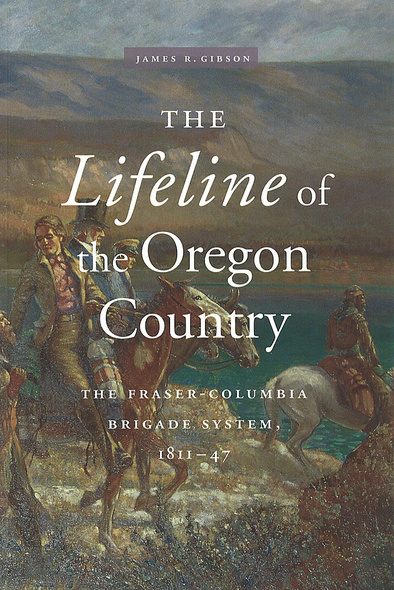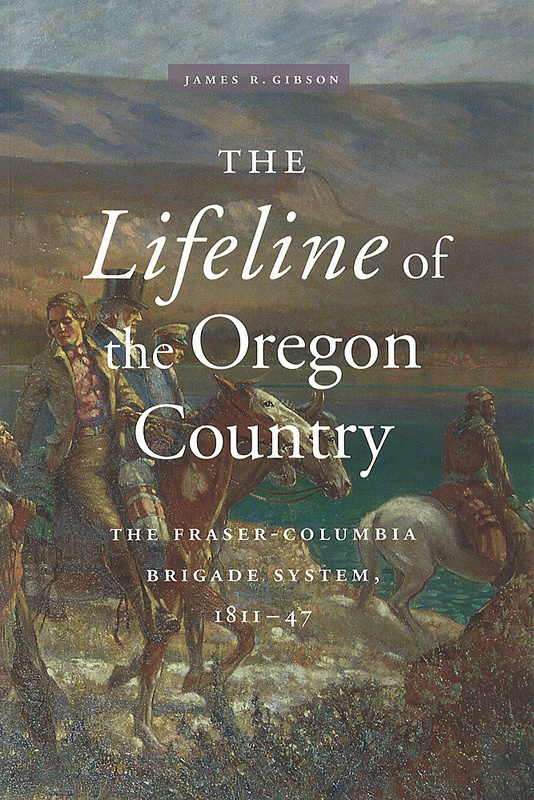
The Lifeline of the Oregon Country
The Fraser-Columbia Brigade System, 1811-47
“Furs is what brings us,” remarked an early trader in the Oregon Country, adding, however, that “the difficulty of getting the necessary supplies will continue to operate against it,” located as it was, “on the worst side of the Rocky Mountains.” Fortunately, the discovery in 1805 by Lewis and Clark that the Columbia River was navigable by canoe or boat to the Pacific led to the logistical linking of the New Caledonia and Columbia Districts by means of the Fraser-Columbia brigade system. First used in 1811 by the North West Company, this transport system of North canoes, Indian pack horses, and Columbia batteaux eventually became the lifeline of the fur trade of the Hudson’s Bay Company’s Columbia Department until 1847, when the route was severed by the extension of the Canada-US border along the forty-ninth parallel to the Pacific.
In The Lifeline of the Oregon Country, James Gibson compellingly immerses the reader in one of the most intractable problems faced by the Hudson’s Bay Company: how to realize wealth from such a remote and formidable land. The personalities, places, obstacles, and operations involved in the brigade system are all described in fascinating detail, stretch by stretch from Fort St. James, the depot of New Caledonia on the upper reaches of the Fraser River, to Fort Vancouver, the Columbia Department’s entrepôt on the lower Columbia River, and back.
Never before has such a rich collection of primary information concerning the fur trade supply system and the constraining role of logistics been so meticulously assembled. The Lifeline of the Oregon Country will prove indispensable to historians, researchers, and fur trade enthusiasts alike, and is an important contribution to our understanding of the economic history of the Pacific Slope.
Prologue
Part 1: Introduction
1 Opening the Oregon Country
2 Linking the Oregon Country
3 Reforming the Oregon Country
Part 2: The Outgoing Brigade
4 Canoeing down the Fraser: From Stuart’s Lake to Alexandria
5 Packhorsing over the Mountain: From Alexandria to Thompson’s River
6 Packhorsing between the Fraser and the Columbia: From Thompson’s River to Okanagan
7 Boating down the Columbia: The Easy Leg from Okanagan to Walla Walla
8 Boating down the Columbia: The Hard Leg from Walla Walla to the Sea
Part 3: The Incoming Brigade
9 At the Sea: The “Grand Depot” and “General Rendezvous”
10 Boating up the Columbia: The Hard Leg from the Sea to Walla Walla
11 Boating up the Columbia: The Easy Leg from Walla Walla to Okanagan
12 Packhorsing between the Columbia and the Fraser: From Okanagan to Thompson’s River
13 Packhorsing over the Mountain: From Thompson’s River to Alexandria
14 Canoeing up the Fraser: From Alexandria to Stuart’s Lake
Epilogue
Appendixes
1 Chief Factor William Connolly’s Journal of the Brigade from New Caledonia to Fort Vancouver and Return, May 5-September 23, 1826
2 Chief Factor Peter Warren Dease’s Journal of the Brigade from New Caledonia to Fort Vancouver and Return, May 7-September 13, 1831
Notes
Bibliography
Index





